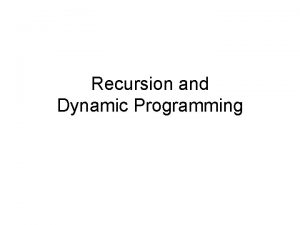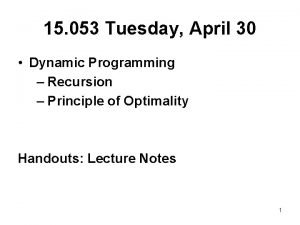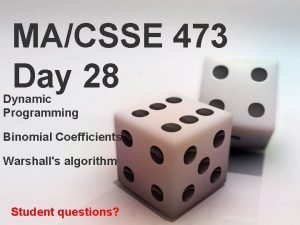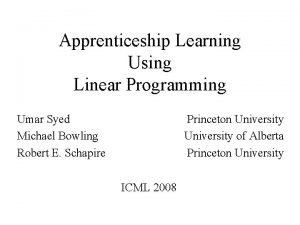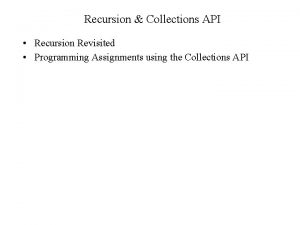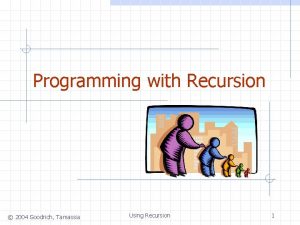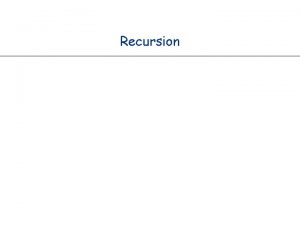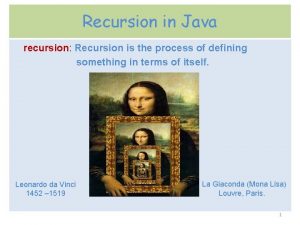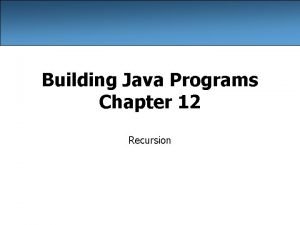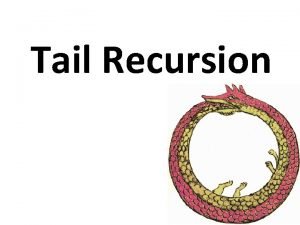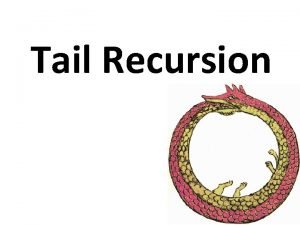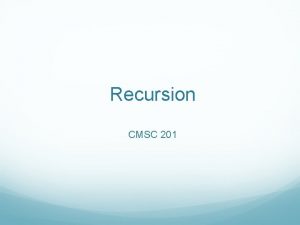Programming with Recursion Using Recursion 1 The Recursion
























- Slides: 24

Programming with Recursion Using Recursion 1

The Recursion Pattern (§ 2. 5) Recursion: when a method calls itself Classic example--the factorial function: n n! = 1· 2· 3· ··· · (n-1)· n Recursive definition: As a Java method: // recursive factorial function public static int recursive. Factorial(int n) { if (n == 0) return 1; // basis case else return n * recursive. Factorial(n- 1); // recursive case } Using Recursion 2

Content of a Recursive Method Base case(s). n n Values of the input variables for which we perform no recursive calls are called base cases (there should be at least one base case). Every possible chain of recursive calls must eventually reach a base case. Recursive calls. n n Calls to the current method. Each recursive call should be defined so that it makes progress towards a base case. Using Recursion 3

Visualizing Recursion Example recursion trace: Recursion trace A box for each recursive call An arrow from each caller to callee An arrow from each callee to caller showing return value return 4*6 = 24 call final answer recursive. Factorial(4) return 3*2 = 6 call recursive. Factorial(3) return 2*1 = 2 call recursive. Factorial(2) call return 1*1 = 1 recursive. Factorial(1) Using Recursion call return 1 recursive. Factorial(0) 4

Example – English Rulers Define a recursive way to print the ticks and numbers like an English ruler: Using Recursion 5

A Recursive Method for Drawing Ticks on an English Ruler // draw a tick with no label public static void draw. One. Tick(int tick. Length) { draw. One. Tick(tick. Length, - 1); } // draw one tick public static void draw. One. Tick(int tick. Length, int tick. Label) { for (int i = 0; i < tick. Length; i++) System. out. print("-"); if (tick. Label >= 0) System. out. print(" " + tick. Label); System. out. print("n"); } public static void draw. Ticks(int tick. Length) { // draw ticks of given length if (tick. Length > 0) { // stop when length drops to 0 draw. Ticks(tick. Length- 1); // recursively draw left ticks draw. One. Tick(tick. Length); // draw center tick draw. Ticks(tick. Length- 1); // recursively draw right ticks } } public static void draw. Ruler(int n. Inches, int major. Length) { // draw ruler draw. One. Tick(major. Length, 0); // draw tick 0 and its label for (int i = 1; i <= n. Inches; i++) { draw. Ticks(major. Length- 1); // draw ticks for this inch draw. One. Tick(major. Length, i); // draw tick i and its label } } Using Recursion 6

Visualizing the Draw. Ticks Method An interval with a central tick length L >1 is composed of the following: n n n draw. Ticks (3) an interval with a central tick length L-1, a single tick of length L, an interval with a central tick length L-1. Output draw. Ticks (2) draw. Ticks (1) draw. Ticks (0) draw. One. Tick (3) draw. Ticks (2) (previous pattern repeats ) Using Recursion 7

Using Recursion 8

Recall the Recursion Pattern (§ 2. 5) Recursion: when a method calls itself Classic example--the factorial function: n n! = 1· 2· 3· ··· · (n-1)· n Recursive definition: As a Java method: // recursive factorial function public static int recursive. Factorial(int n) { if (n == 0) return 1; // basis case else return n * recursive. Factorial(n- 1); // recursive case } Using Recursion 9

Linear Recursion (§ 4. 1. 1) Test for base cases. n n Begin by testing for a set of base cases (there should be at least one). Every possible chain of recursive calls must eventually reach a base case, and the handling of each base case should not use recursion. Recur once. n n Perform a single recursive call. (This recursive step may involve a test that decides which of several possible recursive calls to make, but it should ultimately choose to make just one of these calls each time we perform this step. ) Define each possible recursive call so that it makes progress towards a base case. Using Recursion 10

A Simple Example of Linear Recursion Algorithm Linear. Sum(A, n): Example recursion trace: Input: A integer array A and an integer n = 1, such that A has at least n elements Output: call return 15 + A[4] = 15 + 5 = 20 Linear. Sum (A, 5) call The sum of the first n integers in A if n = 1 then return A[0] else return Linear. Sum(A, n - 1) + A[n - 1] Using Recursion return 13 + A[3] = 13 + 2 = 15 Linear. Sum (A, 4) call return 7 + A[2] = 7 + 6 = 13 Linear. Sum (A, 3) call return 4 + A[1] = 4 + 3 = 7 Linear. Sum (A, 2) call return A[0] = 4 Linear. Sum (A, 1) 11

Reversing an Array Algorithm Reverse. Array(A, i, j): Input: An array A and nonnegative integer indices i and j Output: The reversal of the elements in A starting at index i and ending at j if i < j then Swap A[i] and A[ j] Reverse. Array(A, i + 1, j - 1) return Using Recursion 12

Defining Arguments for Recursion In creating recursive methods, it is important to define the methods in ways that facilitate recursion. This sometimes requires we define additional paramaters that are passed to the method. For example, we defined the array reversal method as Reverse. Array(A, i, j), not Reverse. Array(A). Using Recursion 13

Computing Powers The power function, p(x, n)=xn, can be defined recursively: This leads to an power function that runs in O(n) time (for we make n recursive calls). We can do better than this, however. Using Recursion 14

Recursive Squaring We can derive a more efficient linearly recursive algorithm by using repeated squaring: For example, 24 = 2(4/2)2 = (22)2 = 42 = 16 25 = 21+(4/2)2 = 2(22)2 = 2(42) = 32 26 = 2(6/ 2)2 = (26/2)2 = (23)2 = 82 = 64 27 = 21+(6/2)2 = 2(23)2 = 2(82) = 128. Using Recursion 15

A Recursive Squaring Method Algorithm Power(x, n): Input: A number x and integer n = 0 Output: The value xn if n = 0 then return 1 if n is odd then y = Power(x, (n - 1)/ 2) return x · y ·y else y = Power(x, n/ 2) return y · y Using Recursion 16

Analyzing the Recursive Squaring Method Algorithm Power(x, n): Input: A number x and integer n = 0 Output: The value xn if n = 0 then return 1 if n is odd then y = Power(x, (n - 1)/ 2) return x · y else y = Power(x, n/ 2) return y · y Using Recursion Each time we make a recursive call we halve the value of n; hence, we make log n recursive calls. That is, this method runs in O(log n) time. It is important that we used a variable twice here rather than calling the method twice. 17

Tail Recursion Tail recursion occurs when a linearly recursive method makes its recursive call as its last step. The array reversal method is an example. Such methods can be easily converted to nonrecursive methods (which saves on some resources). Example: Algorithm Iterative. Reverse. Array(A, i, j ): Input: An array A and nonnegative integer indices i and j Output: The reversal of the elements in A starting at index i and ending at j while i < j do Swap A[i ] and A[ j ] i =i+1 j =j-1 return Using Recursion 18

Binary Recursion (§ 4. 1. 2) Binary recursion occurs whenever there are two recursive calls for each non-base case. Example: the Draw. Ticks method for drawing ticks on an English ruler. Using Recursion 19

A Binary Recursive Method for Drawing Ticks // draw a tick with no label public static void draw. One. Tick(int tick. Length) { draw. One. Tick(tick. Length, - 1); } // draw one tick public static void draw. One. Tick(int tick. Length, int tick. Label) { for (int i = 0; i < tick. Length; i++) System. out. print("-"); if (tick. Label >= 0) System. out. print(" " + tick. Label); System. out. print("n"); } public static void draw. Ticks(int tick. Length) { // draw ticks of given length if (tick. Length > 0) { // stop when length drops to 0 draw. Ticks(tick. Length- 1); // recursively draw left ticks draw. One. Tick(tick. Length); // draw center tick draw. Ticks(tick. Length- 1); // recursively draw right ticks } } public static void draw. Ruler(int n. Inches, int major. Length) { // draw ruler draw. One. Tick(major. Length, 0); // draw tick 0 and its label for (int i = 1; i <= n. Inches; i++) { draw. Ticks(major. Length- 1); // draw ticks for this inch draw. One. Tick(major. Length, i); // draw tick i and its label } } Using Recursion Note the two recursive calls 20

Another Binary Recusive Method Problem: add all the numbers in an integer array A: Algorithm Binary. Sum(A, i, n): Input: An array A and integers i and n Output: The sum of the n integers in A starting at index i if n = 1 then return A[i ] return Binary. Sum(A, i, n/ 2) + Binary. Sum(A, i + n/ 2, n/ 2) Example trace: 0, 8 0, 4 4, 4 0, 2 0, 1 2, 2 1, 1 2, 1 4, 2 3, 1 4, 1 Using Recursion 6, 2 5, 1 6, 1 7, 1 21

Computing Fibanacci Numbers Fibonacci numbers are defined recursively: F 0 = 0 F 1 = 1 Fi = Fi-1 + Fi-2 for i > 1. As a recursive algorithm (first attempt): Algorithm Binary. Fib(k): Input: Nonnegative integer k Output: The kth Fibonacci number Fk if k = 1 then return k else return Binary. Fib(k - 1) + Binary. Fib(k - 2) Using Recursion 22

Analyzing the Binary Recursion Fibonacci Algorithm Let nk denote number of recursive calls made by Binary. Fib(k). Then n n 0 = 1 n 1 = 1 n 2 = n 1 + n 0 + 1 = 1 + 1 = 3 n 3 = n 2 + n 1 + 1 = 3 + 1 = 5 n 4 = n 3 + n 2 + 1 = 5 + 3 + 1 = 9 n 5 = n 4 + n 3 + 1 = 9 + 5 + 1 = 15 n 6 = n 5 + n 4 + 1 = 15 + 9 + 1 = 25 n 7 = n 6 + n 5 + 1 = 25 + 1 = 41 n 8 = n 7 + n 6 + 1 = 41 + 25 + 1 = 67. Note that the value at least doubles for every other value of nk. That is, nk > 2 k/2. It is exponential! Using Recursion 23

A Better Fibonacci Algorithm Use linear recursion instead: Algorithm Linear. Fibonacci(k): Input: A nonnegative integer k Output: Pair of Fibonacci numbers (Fk, Fk-1) if k = 1 then return (k, 0) else (i, j) = Linear. Fibonacci(k - 1) return (i +j, i) Runs in O(k) time. Using Recursion 24
 To understand recursion you must understand recursion
To understand recursion you must understand recursion Recursive thinking definition
Recursive thinking definition Dynamic programming recursion example
Dynamic programming recursion example Bh&m
Bh&m Using recursion in models and decision making
Using recursion in models and decision making Using recursion in models and decision making sheet 3
Using recursion in models and decision making sheet 3 Selection sort using recursion
Selection sort using recursion Perbedaan linear programming dan integer programming
Perbedaan linear programming dan integer programming Greedy vs dynamic
Greedy vs dynamic What is system programing
What is system programing Integer programming vs linear programming
Integer programming vs linear programming Programing adalah
Programing adalah Interrupts of 8051 microcontroller
Interrupts of 8051 microcontroller Binomial coefficient using dynamic programming
Binomial coefficient using dynamic programming Solving goal programming problems using simplex method
Solving goal programming problems using simplex method Apprenticeship learning using linear programming
Apprenticeship learning using linear programming Hình ảnh bộ gõ cơ thể búng tay
Hình ảnh bộ gõ cơ thể búng tay Slidetodoc
Slidetodoc Bổ thể
Bổ thể Tỉ lệ cơ thể trẻ em
Tỉ lệ cơ thể trẻ em Voi kéo gỗ như thế nào
Voi kéo gỗ như thế nào Chụp phim tư thế worms-breton
Chụp phim tư thế worms-breton Chúa sống lại
Chúa sống lại Các môn thể thao bắt đầu bằng từ đua
Các môn thể thao bắt đầu bằng từ đua Thế nào là hệ số cao nhất
Thế nào là hệ số cao nhất

